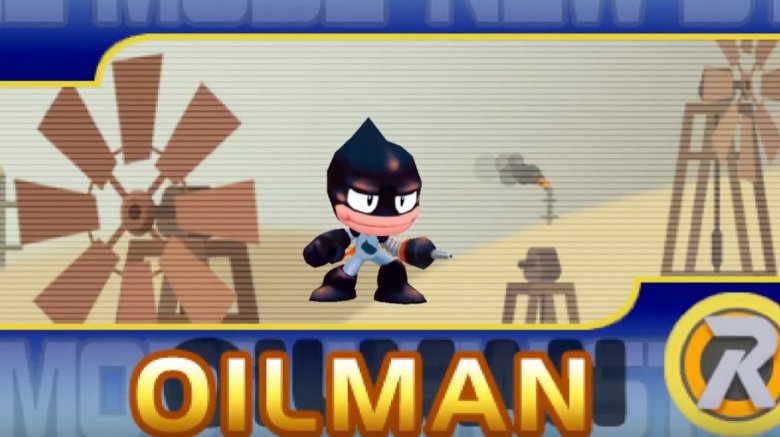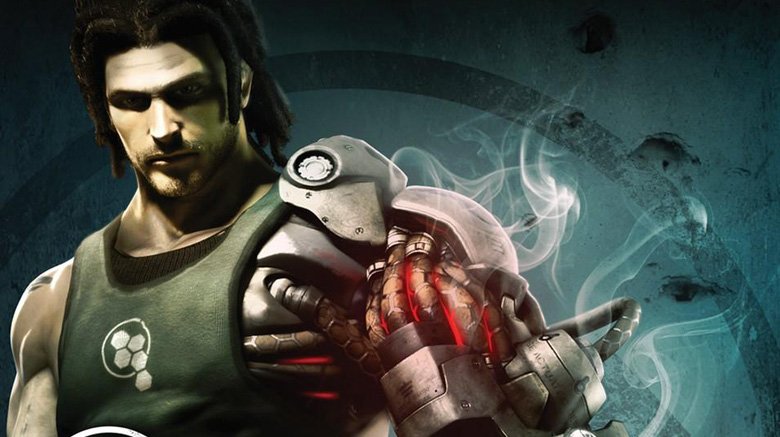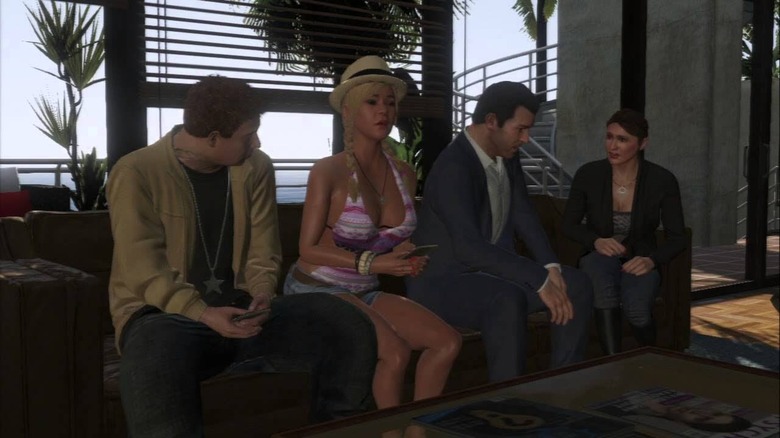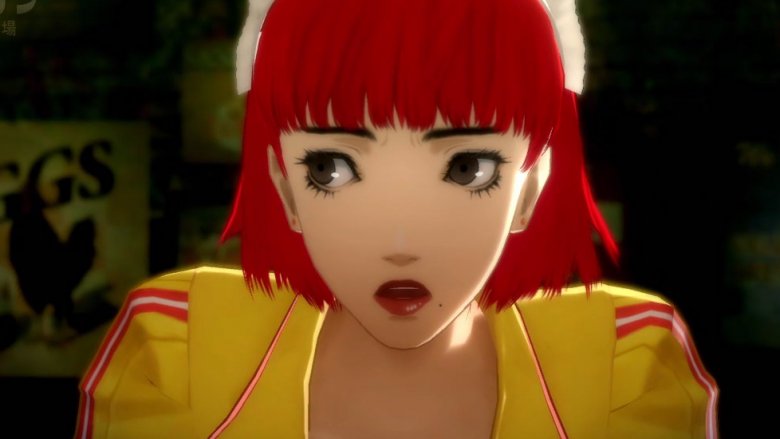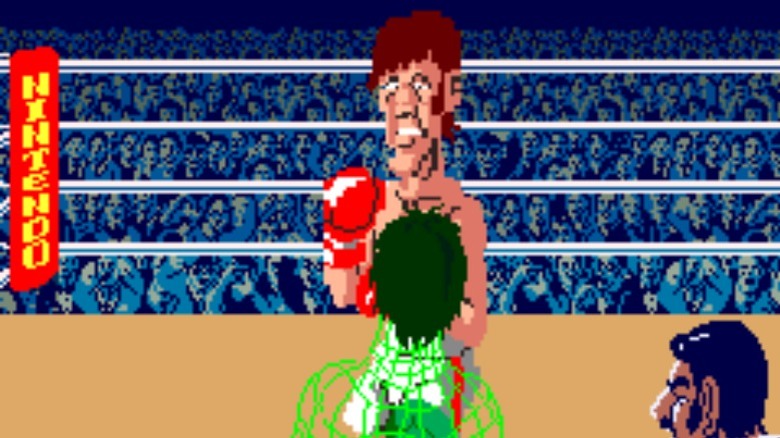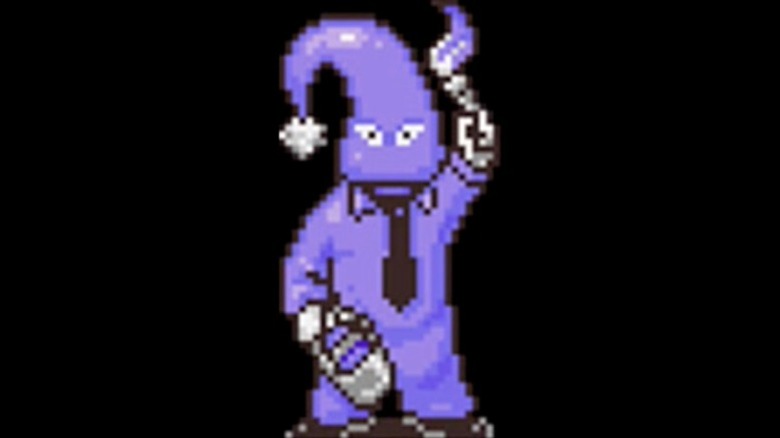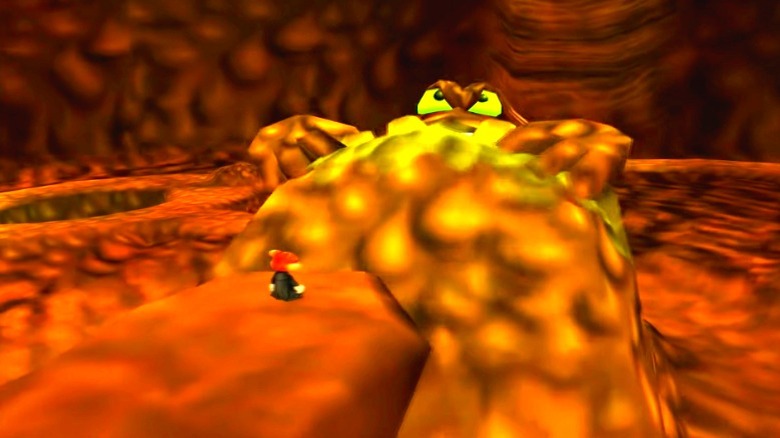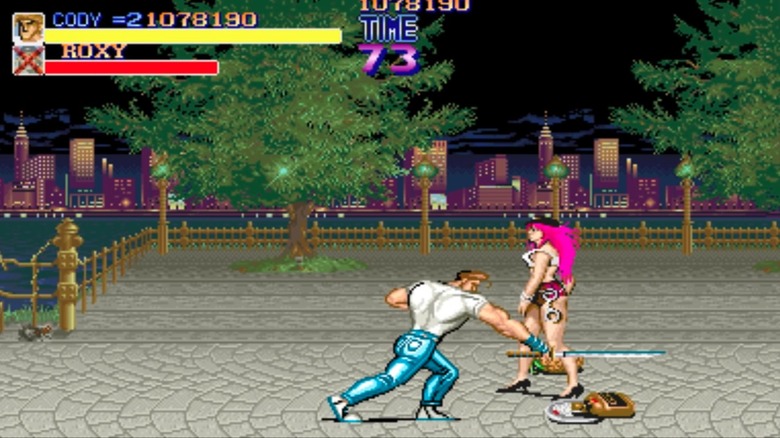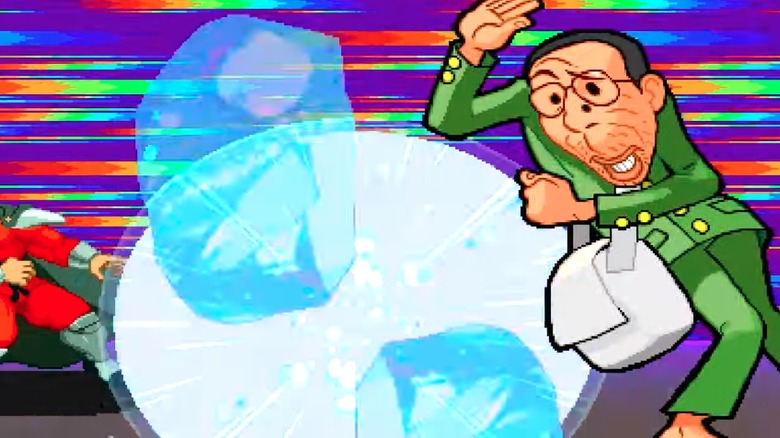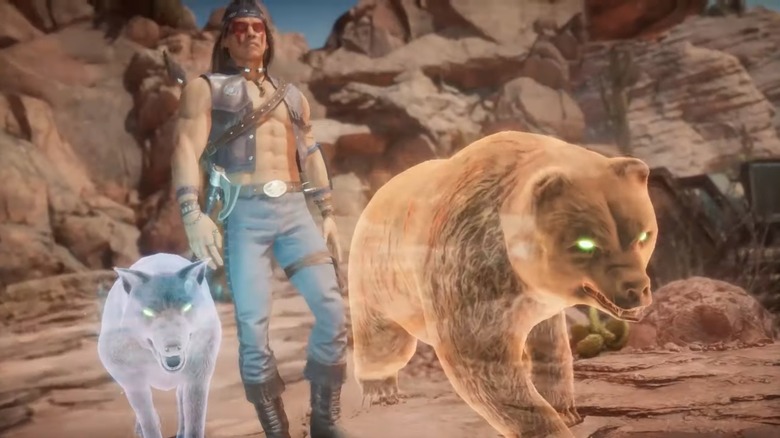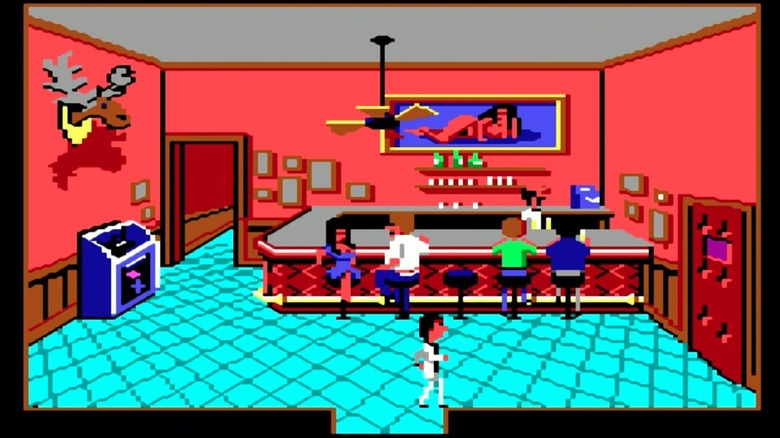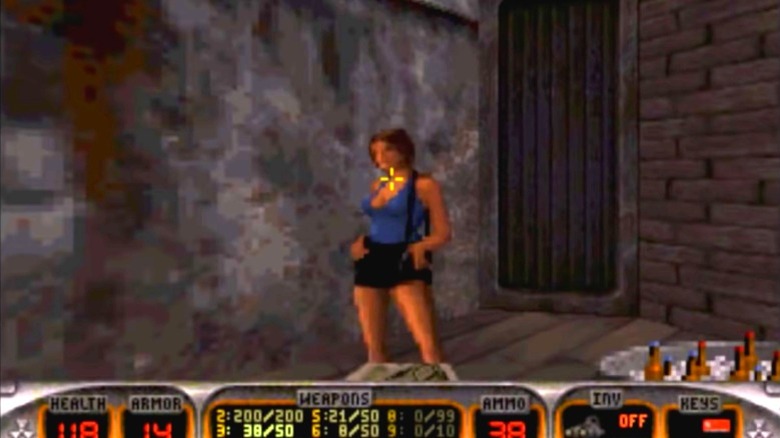The Most Offensive Video Game Characters Of All Time
Video games are a relatively new form of media, and for a long time, most of them were pretty light on story. As a result, characters were often boiled down to simple motivations like "run right, rescue Princess," or "walk around in multiple directions, rescue other princess." It's not surprising that video game characters started out simple. You have to start somewhere, and no one expected character storylines that would win literary prizes to come on the heels of Tetris or Pong.
But unfortunately, some of the two-dimensional characters that did make it to the very-small screen veered into stereotypes that can be pretty offensive, whether you're looking back on 8-bit classics or just staring in shock at how something made it into a game from this decade. From accidental and unfortunate imagery to cringe-inducing writing and voice acting, here are the most offensive video game characters of all time.
Oil Man (Mega Man: Powered Up)
The best thing you can say about Oil Man is that he probably wasn't awful on purpose. When Capcom decided to remake the original Mega Man game in 2006 as a 20th-anniversary project called Mega Man: Powered Up, they made a few changes. The graphics were updated to a new 3-D style, a new mode let you play through the game as any of the bosses, and since the original Mega Man was the only game in the franchise to feature six robot masters instead of the usual eight, they added two new characters to the mix. One, Time Man, was just another spin on a formula they'd used before with characters like Flash Man. The other, unfortunately, was Oil Man, an interesting idea for a character that was saddled with a design that made him look like he was straight out of a 19th-century minstrel show.
The design was so bad, in fact, that he was given a slightly different color scheme and left off the box art for the American and European releases for the games, as though surprising players with an accidental racist caricature would go better. To make matters worse, while Capcom thankfully didn't give him a stereotypical voice, his dialogue in the game is loaded up with lines like "how's about chillin' out" and "I don't know nothin' about that" that don't do him any favors, and he literally shouts "yo!" every time you jump.
The good news is this is one of the few stereotypes in gaming that has a relatively happy ending. When Oil Man appeared in the Archie Comics series based on the Mega Man games, artist Chad Thomas gave him a redesign that added a scarf that was reminiscent of Japanese superheroes like Kamen Rider. Not only did that cover up the more offensive aspects of his original design, it also added a nice sense of motion that made him seem like a more dynamic threat. It's the definition of making the best of a bad situation, but at least it's something.
Lo Wang (Shadow Warrior)
Have you ever wondered what Duke Nukem 3D would be like if it was just straight-up racist? Well, even if you weren't, we're sorry to report that 3D Realms decided to answer that question anyway with the release of 1997's Shadow Warrior.
Lo Wang, whose name is exactly the joke you think it is, is voiced by John William Galt, and delivers the game's one-liners in such a monumentally offensive fashion that you'd think his enemies could be defeated by racism as easily as they were defeated by bullets. It's one thing for Western developers to play with distinctly Japanese elements like katanas, zaibatsu mega-corporations, and the Yakuza, but to do it while your main character delivers lines like "ooh, you good-rooking sailor babe" and "just rike Nagasaki" goes way beyond appreciation and into the (3D) realm of something that definitely should've been tossed in the trash rather than released to the public.
Surprisingly, Shadow Warrior was rebooted in 2013. While the 21st-century's version of Lo Wang started off a whole lot better than his 1997 counterpart, with dialogue that set him up as a capable hit man with a penchant for one-liners, the 2016 follow-up wasn't so lucky. Polygon's Carli Velocci referred to even the new version of Wang as "a walking Asian stereotype" in an "outdated, unfunny game" full of "horrible dialogue and racist stereotyping." As harsh as that is, it's still nicer than this guy deserves.
Rad Spencer's left arm (Bionic Commando)
Video games have seen so many ill-advised grim-and-gritty reboots that it's sometimes surprising that there wasn't a 2005 Tetris game about how the L-shaped piece was trying to cast the others into a hell where they would be tortured for their sins by being stacked on each other for eternity. With actual titles like 2009's Bionic Commando reboot, that's not too far from the truth.
It's no secret that video games often use female characters as little more than metaphorical props, killing them off to advance someone else's story. Bionic Commando takes it one step further by making its main character's wife an actual prop: It's revealed as you go through the story that the bionic arm you've been using to move around the game was actually made out of your dead wife so it could connect with you on an emotional level. No, really.
Say what you will about games like Super Princess Peach, where Mario's lady-friend fights enemies by uncontrollable emotions, or Soul Calibur, which boasts some of the most ridiculously oversexualized women in the history of video games, but at least Peach and Ivy are actual characters. Being reduced to a male hero's literal left arm is taking things to a whole new level.
The De Santa family (Grand Theft Auto V)
It's to be expected that most of the characters in Grand Theft Auto are going to be terrible people. It is, after all, a game entirely focused on criminals and all the reprehensible crimes they can do in a world where everyone just leaves rocket launchers and Uzis lying around in the street.
Grand Theft Auto V features the most infinitely hateable jerks of the entire franchise, but surprisingly, the worst ones aren't any of the main characters. Trevor might be bad, but a completely amoral meth-head redneck who makes his first appearance by stomping one of the previous game's main characters to death has nothing on the true villains of that game: Michael's terrible, terrible family.
They're stereotypes in that they're some pretty familiar tropes — the henpecking and shrewish wife, the bitter and fame-hungry daughter, and the useless, faux-Juggalo son — but the offense here comes less from that and more from another factor. Despite building an entire open-world game around the ability to murder as much as you please, you can't kill the most annoying people in the game. If you try, you just wind up getting hospital bills.
Erica (Catherine)
For a game that's all about the complications of sexuality and interpersonal relationships, it was almost inevitable that Catherine would make a few mistakes along the way. With Erica, however, the problem actually isn't in the character herself. It's how everyone else reacts to her.
Erica is a trans woman in her 30s, and throughout the game, she's presented as kind, smart, desirable, and extremely well-liked ... by everyone except the other main characters of the game. At multiple points, Vincent, the protagonist, makes casually transphobic comments about her, insisting that she's not actually a woman, without ever getting any real consequences for it — and Erica is meant to be one of his oldest friends. It's not just limited to interactions within the game, either; even the game mechanics get in on the act. A major plot point in the game revolves around a specific sort of nightmare that only happens to male characters, and eventually, Erica starts having them, too, and the credits and official art book refer to her by her previous name.
Needless to say, Erica's portrayal has remained controversial in the years since Catherine's release, and sadly, some players have picked up where Vincent left off. If you check out the Fandom wiki for Catherine, you'll find that Erica's page has been locked down due to edits from users who changed all her pronouns to "he" and said she was a "freak" who "deserves to die."
Letitia (Deus Ex: Human Revolution)
Deus Ex: Human Revolution was almost universally acclaimed, racking up a 90 percent score on Metacritic. That said, one of this video game's characters left most reviewers and players stunned by her inclusion: an informant named Letitia, also known colloquially as "the trash lady."
No less than Time magazine called her "the worst part of Deus Ex: Human Revolution" and "a really bad part of a really good game," and it's easy to see why. In an otherwise well-crafted cyberpunk future, her heavily accented, over-the-top dialogue sticks out as surprisingly offensive. It's obvious that Letitia is meant to be a throwback to informants from '70s cop shows, but it's just as obvious that a game made in 2011 should've probably moved past stereotypes seen in the '70s. It might be forgivable if there was any indication that Letitia was affecting a personality that would allow her to go unnoticed by others, but there's really no indication of that in the game. Instead, while they agreed it was likely a misstep and not an intentional bit of hatred, she's gone down in gaming history as what Polygon called "that weirdly racist NPC."
Kung Pow (Clay Fighter 63 ⅓)
Shadow Warrior might've set the standard for racist caricatures of Asian people in 1997, but the following year, Clay Fighter 63 ⅓ did its level best to top that by introducing a new character into its claymation fighting game.
Kung Pow was, as you might expect from the name, a kung-fu enthusiast who also happened to be a Chinese chef. That, at least, was Interplay's rather tenuous justification for having him shout "egg foo yung!" and "chop suey!" while fighting his enemies, along with the cringe-inducing "would you rike soy sauce with that?"
The only thing that makes it worse is that it's not just astonishingly racist, it's also a criminal waste of voiceover talent. Clay Fighter 63 ⅓ boasted a cast that by any measure is way better than it should be, including legendary voice actors like Frank Welker (Fred from Scooby Doo), Dan Castellaneta (Homer Simpson), and Jim Cummings (Darkwing Duck). Kung Pow himself was voiced by Jess Harnell, who's probably best known for the role of Wakko Warner on Animaniacs, and who probably ought to leave this one off his resume.
Ash (Bare Knuckle 3)
Most of the time, when things in a game from Japan are changed from their original forms to something the publisher deems more suited to American audiences, it can seem pretty arbitrary. Nintendo, for instance, had a blanket ban on any and all religious iconography during the NES and SNES era for games released in America, meaning that not only were crosses removed from tombstones in games like Castlevania (where a cross-shaped weapon was referred to as a "boomerang"), they were also taken off the hospitals in Earthbound. When Sega made the call to remove Ash from the U.S. release of Streets of Rage 3, however, that was probably the right call.
To say Ash is an offensive stereotype of a gay man is honestly doing a disservice to offensive stereotypes that at least make some attempt at subtlety. When he shows up as the boss of a stage that takes place on the docks (of course), he's dressed like a homophobic nightmare: a biker-style leather cap and vest over a shiny black singlet, high-heeled leather boots, lime green thigh-high stockings, and a wicked mustache/mutton chops combo. Throw in the limp-wristed running and the ballet-style grand jeté leaps, and it's almost so far over the top that it's hard to find offensive. Almost.
The real kicker, though, comes from Ash's choice of accessory. To round out his outfit, Ash sports a massive gold chain bearing a Venus symbol, likely because of the offensive view of gay men as not just "effeminate," but actually wanting to be women. Clearly, there's a good reason why Ash never made it out of Japan. He wasn't even replaced — in other regions, Streets of Rage 3's first level doesn't have a boss at all, and Ash's boat, minus Ash, just sails off after dropping a few regular enemies for you to trounce on your way to victory.
Garcia Hotspur (Shadows of the Damned)
Legendary designer Suda51, whose work includes No More Heroes and Killer 7, is well known for crafting some pretty strange games with a lot of satirical layers. With that in mind, it's possible, and even easy, to look at Shadows of the Damned as a game that's intentionally doing everything as a commentary about toxic masculinity. The problem is that to make that commentary, the game doesn't just touch on its subject matter, it revels in it. If the best satire is done with the surgical focus of a scalpel, Shadows of the Damned goes at it with all the subtlety of a chainsaw.
The game's protagonist, Garcia Hotspur, is an over-the-top man's man caricature right from the moment you hear his name. He's the stereotype of the hot-blooded, sex-crazed Latino that, on a scale of one to ten, is cranked up to somewhere around 47. Need proof? Just check out the level where Garcia's gun, a skull-shaped pistol that shoots bones called the Boner, grows to gigantic proportions so that he can fight kaiju-sized demons by thrusting his hips at them and yelling "taste my Big Boner." Oh, and if that was a little too subtle for you, you acquire the Big Boner by diving through a portal on a picture of a lady demon's bathing suit area, drunkenly stumbling into a strip club, and then calling a phone sex line. Oh, and it's made from your buddy who's a floating skull. His name is Johnson.
Again, not exactly subtle. To be fair, though, the game deals with every aspect of Garcia's relationship with his girlfriend in exactly as ridiculous a fashion. The game is all about journeying to Hell to find her after she's been kidnapped by the devil, but periodically, she'll actually show up and you'll have to run away from her because, you know, women be crazy.
Almost every other boxer in Punch-Out!!
Fighting games in general tend to rely pretty heavily on stereotypes, but no major franchise has ever gone as hard into it as Nintendo's Punch-Out!! With a few exceptions (which still tend to be rooted in the one-note characterization that you'd expect from a game where the plot is "punch, and sometimes dodge") the whole cast is drawn from a roster of ridiculously overblown caricatures.
He was toned down a little for the NES as Soda Popinski, but in the arcade version of Super Punch-Out!!, the Russian competitor was originally known as Vodka Drunkenski, and that's just the tip of the iceberg for these video game characters. Vodka was joined in that game by Hong Kong's Dragon Chan, who can't resist using kung-fu kicks in a boxing match, and a hairy hillbilly called Bear Hugger. They weren't the first or the last: The previous version included an Italian boxer named Pizza Pasta, and by the time it moved to the NES, Punch-Out!! also included India's own Great Tiger draping his namesake animal's skin over his corner post. Even once it moved to the Super NES, the series introduced an Irish fighter whose special attack was called the "Irish jig," and a Jamaican boxer named Bob Charlie whose special attack is literally referred to in-game as the "shuck and jive." Little Mac just can't get away from these guys.
King Hippo might be a stereotype, too, but we're just not sure of what.
The Happy Happy Cult (Earthbound)
It's hard to describe just how weird 1995's Super Nintendo RPG "EarthBound" is. It's about four kids trying to stop an alien invasion, but it's also full of absurd humor, intentionally ridiculous American stereotypes, and surprisingly creepy undertones. One example of the bizarreness that appears in the game comes fairly early, when the kids reach Happy Happy Village, home of the Happy Happy Cult.
The cult is a religious movement based around, uh, the color blue. The cult tries its best to paint everything blue as per the wishes of its leader. While that's a pretty silly goal, the developers of "EarthBound" decided to show how serious and deadly the cult is by giving them long blue robes and pointed hoods and, oh no, they're Klansmen. Not just Klansmen, but possibly Nazis, as they have big HH letters stamped on their forehead, according to Legends of Localization.
Nintendo of America clearly saw how this would look, because for the American release, they removed the HH and added little puffballs to the tip of the hoods, to make them look more like really big sleeping caps or Santa hats or something. Just anything but Klansmen, according to the EarthBound Wiki. The HH was supposedly removed because translators were afraid it would look like a "KK" at low resolution, but it's also worth noting that HH is often used as a code word for Neo-Nazis as a stand-in for "Heil Hitler."
The Great Mighty Poo (Conker's Bad Fur Day)
Another cult Nintendo hit came in the Nintendo 64 days when, tired of their reputation for making cute kid games, Rare Software opted to make an M-rated platformer starring a bushy-tailed squirrel with a drinking habit and obsession with money. In fact, most of the critters in "Conker's Bad Fur Day" are relatively adorable, but with a twist, such as a queen bee who is insanely violent and struggles with her cheating husband, or a beautiful sunflower who happens to be well-endowed.
This does not apply for the boss creature known as The Great Mighty Poo, who is best described as, well, a great, mighty poo, leader of a world largely made of feces and populated by foul-mouthed dung beetles. The developers chucked maturity right out the window when designing the Poo, who has teeth made of corn kernels, sings opera, and flings large pieces of dung at the player, according to Conker Wiki. His theme song is essentially him singing about bodily waste and how he intends to use it to injure Conker.
By lobbing rolls of toilet paper into the beast's mouth and, eventually, literally flushing him into oblivion, players can defeat the mountain of fecal matter, but not before sacrificing their sense of tastelessness first. While the entire game is fairly offensive and immature, The Great, Mighty Poo takes the (please not chocolate) cake.
Poison (Final Fight)
Capcom's 1989 beat-'em-up side scroller "Final Fight" is famous for its arcade cabinet, which regularly sucked up a great many quarters, as well as its various home adaptations, including a version for the Super Nintendo that was basically a launch title for the iconic console. It included a wide variety of enemies appearing over a half-dozen stages (more or less, depending on which version you played), but two are particularly infamous — Poison and Roxy.
The only female characters in the Japanese version of the game, Poison and Roxy stood out enough that the original developers declared that the two punk-clad women weren't actually cis women, but trans, thus getting around that whole nasty "buff dudes beating up women" vibe, while simultaneously opening up a new can of worms, according to CBR. (The Super Nintendo adaptation avoided things completely by replacing them with new, male characters.)
However, while Roxy dropped off the face of the Earth, Poison has reappeared several times in other Final Fight games and has even crossed over into Capcom's mega-franchise, "Street Fighter." However, Capcom has repeatedly dropped the ball on Poison's characterization by wavering on whether or not she's trans or cis (often in incredibly cringe-worthy ways, depending on what year it was), hyper-sexualizing her, or adding even more fetishistic elements to her costumes in various games. Please, Capcom, let Poison live her best life. Give the lady some respect, for goodness sake.
Norimaro (Marvel Super Heroes vs. Street Fighter)
In 1997, Capcom still ruled the arcades with its "Street Fighter" franchise and had made a ton of headway with its "Marvel Super Heroes" series as well, a similar fighting game that used Marvel comic characters instead. And then, like peanut butter and chocolate, Capcom combined the two and created "Marvel Super Heroes vs. Street Fighter." Arcades might not last much longer, but that didn't matter.
In the game's original Japanese version, Capcom invited Japanese comedian Noritake Kinashi to design a character, for some reason, and he came up with Norimaro, a young student who was obsessed with Chun-Li and the other "Street Fighter" characters, according to Marvel vs. Capcom Wiki. While the series had previously featured young characters, such as high school student Sakura, and joke characters, like attention-seeker Dan, Norimaro was both, and also incredibly skeevy to boot.
Norimaro had several animations of himself dreaming of various female characters (and Russian wrestler Zangief) and then immediately experiencing a nosebleed, a common way of expressing sexual frustration in Japanese manga and anime. He also makes creepy comments to female fighters after battles and has a special daydream bubble for Chun-Li showing a very pointed upskirt shot. Norimaro never made it into international releases, largely because the character wouldn't have made much sense outside of Japan, but his lecherousness probably didn't help things.
Nightwolf (Mortal Kombat 3)
If you've not heard, America has a nasty history when it comes to Native Americans, and that isn't helped by shoddy pop culture depictions of Native American characters. One of the most ridiculous examples of this is Nightwolf, a character developed for "Mortal Kombat 3," who is described as a shaman of the fictional Makota tribe. Naturally, he has a mish-mash of styles and designs based on an assortment of Native American tribes, despite the fact that Native American tribes were and still are, well, pretty different from one another.
His violent attacks, especially Mortal Kombat's traditional fatalities, often involve hatchets, cementing him as a stereotype of Native American savagery and reinforcing the idea of Native peoples using only primitive tools. His attacks are spirit and animal-based, but not based on any actual Native American religious concepts. Basically, he's a mess of stapled-together stereotypes, according to Indian Country Today.
What's worse, though, is the character has been rebooted more than once (most recently in 2019's "Mortal Kombat 11") and the developers actually made him worse, increasing the amount of violence and savagery the character displays and giving him new outfits ripped off from even more indigenous groups. The Native American community has reached out to the game's developers about improving the character and reforming him to more accurately represent indigenous peoples, but have been ignored.
Leisure Suit Larry
If you're a younger gamer, you might be unfamiliar with "Leisure Suit Larry," a series of comedic games from the 80s and 90s where players take control of Larry Laffer, a leisure-suit clad creep whose entire goal is to make it with oversexed, misogynist representations of women, according to Mel.
To be clear, the games didn't start out so awful. They were meant to be a satire of what you'd call pick-up artists today. Larry wasn't a hero, he was a fool, and the women he was after were meant to be parodies of 80s and 90s depictions of glamorous women, such as supermodels. (That's not to say those things are good and okay, just that they made a lot more sense at that time.) As the series went on, however, this became less apparent, because, by the mid-90s, the game industry had embraced those stereotypes wholeheartedly and dropped the irony.
After the original run of point-and-click adventure games, Larry took a much-needed hiatus from the game industry, but various developers over the years have tried to reboot the series and turned it into exactly the thing it was parodying, full of gross-out humor ripped straight from an early 2000s coming-of-age comedy. You see, despite being intended for adult audiences, the original games were actually extremely tame. Not so with the current crop, which one only needs to glance at to see that the series has become intensely skeevy.
Duke Nukem
In 1996, just a few years removed from the action hero heyday of the 1980s, a character like Duke Nukem was obvious. A parody of all of those buff, manly dudes from the previous decade, roaming around and kicking alien butt. It's the perfect premise for the early first-person shooter genre. It seemed like the perfect way to grow-up Apogee's Duke Nukem character, previously the star of a series of 2D side-scrolling games who was not the least bit offensive.
Thus, "Duke Nukem 3D" was unleashed on the world. But there was more to Duke than just the 80s action star persona — there was also a metric ton of completely not ironic sexism and hypermasculinity, the things the game was meant to satirize, according to Vice. Instead of confronting the nastier parts of history, the game just dove straight into them, copying them beat-for-beat.
It ended up costing the series in the end. The developers struggled to make the fourth game in the series, but constant technology changes and a desire for perfection kept it under wraps for 15 years. When it was finally released, "Duke Nukem Forever" landed with a thud. Turns out, that kind of humor simply didn't age well more than a decade later, and it's even more cringe-worthy today, more than 25 years after "Duke Nukem 3D's" release.
